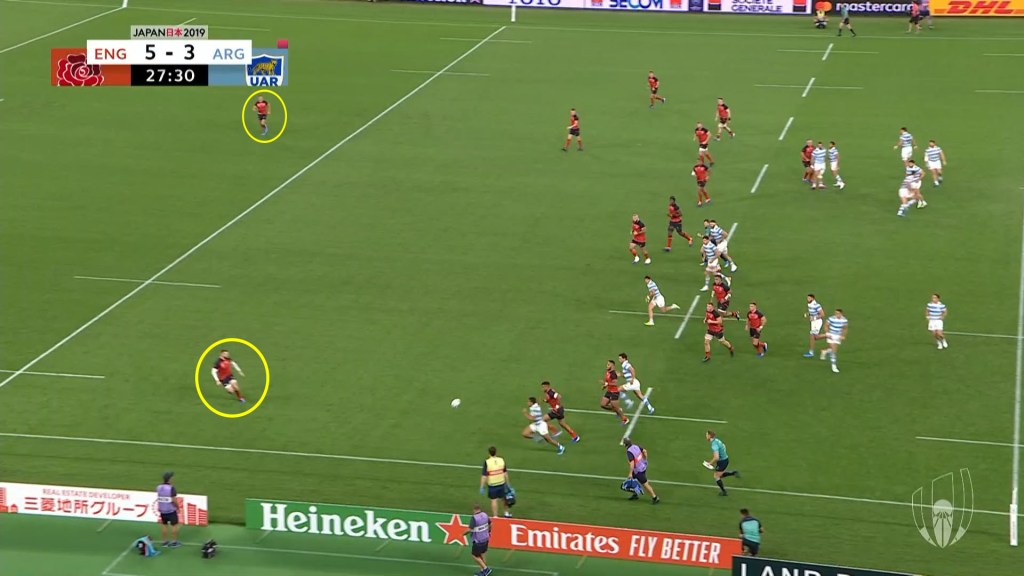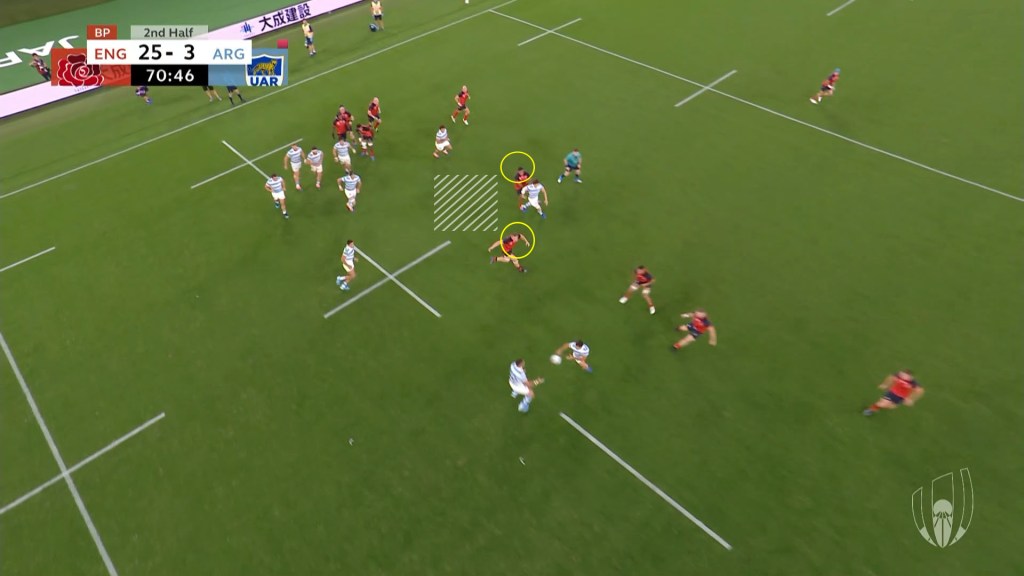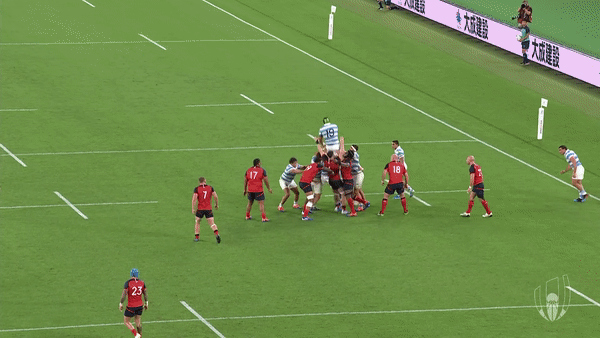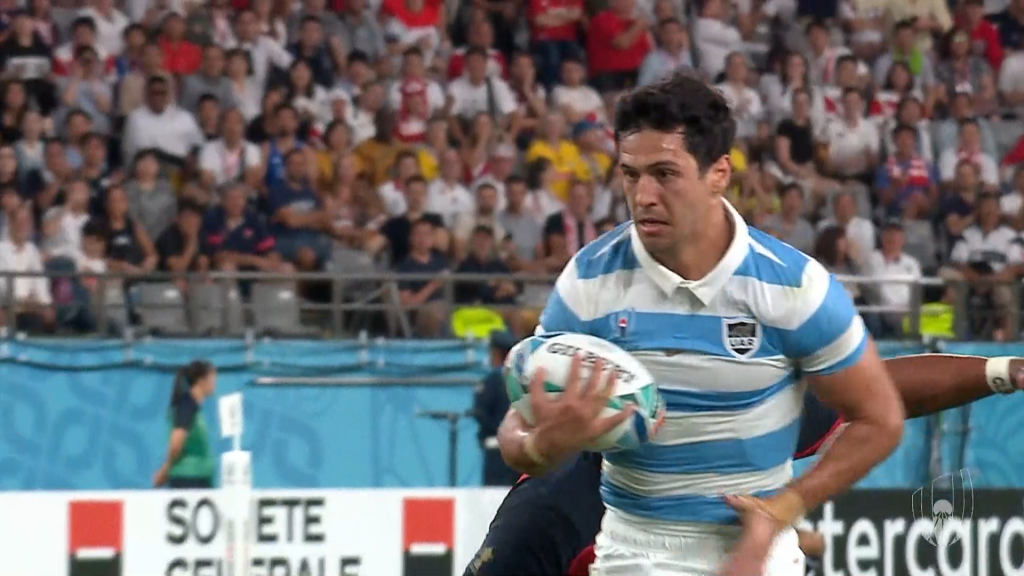
Although England were comfortable 39-10 winners over Argentina on Saturday, it was Los Pumas who arguably scored the try of the game in the Pool C clash between the teams. This analysis will look at Argentina’s only try of the game, the structure behind the strike play that produced it and the implications it could have for defensive systems like England’s as the World Cup progresses.
Starting off the article, it’s important to initially explain the way England defend to understand how it informed Argentina’s 71st minute strike play try.

Whereas teams traditionally have defended with a fullback in the centre of the pitch and a winger dropping off on either side, England defend a little differently with a 13-2 structure.
Plainly speaking, what this means is that England have 13 defenders in the front-line of defence and 2 defenders-usually the fullback and a blindside winger as shown below-covering behind on either side of the pitch.

There are two advantages to this defensive formation.
Firstly, by having 13 defenders in the front-line, England have an extra man in their front-line to rush up and pressure the opposition attack into making mistakes.
Secondly, the English defence also always have a player covering either wing for kicks; forcing the opposition to usually kick down the middle where it is advantageous for England on the counter-attack.
Keeping this 13-2 defensive structure in mind for a little later in the article, we will now move on to Argentina’s strike play in the 71st minute to see how they broke the system above down.
To begin with, after winning a penalty in their own half, Argentina initially set up a 6-man lineout just inside England’s 10m line.

As the image above shows, England decide to defend with only 5 forwards in the lineout so that they can get 13 defenders in the front-line as soon as possible and blitz.
Sam Underhill is also standing in the scrum-half position to defend any potential maul if Argentina choose not to pass.
Keep an eye on the two English players circled in the picture above-Underhill and Mako Vunipola-to see how they defend as the play progresses.

Having set a maul, Argentina’s Tomas Lezana quickly breaks; running at Underhill before passing.

While Lezana’s lateral run initially seems ineffective, it’s focus is to draw Underhill out of the line as he tries to fill the front-line of 13 defenders. As the image above indicates, this cleverly creates a gap between England’s back rower and the slower prop Vunipola to exploit.
Although he makes no contact with Vunipola, it’s also worth noting that Lezana also runs beyond his pass just to make sure the space is preserved.
With part 1 of the strike play complete and Vunipola now isolated, Argentina show great passing interplay to work the ball back inside to winger Santiago Carreras. As an aside, some of the more eagle-eyed readers may have spotted that Carreras is initially hiding at the front of the lineout when the strike play begins.

With the ball now in Carreras’ hands, the speed difference between him and Vunipola is too great and the Argentine winger sears through the gap to make a linebreak.
Having beaten the England’s front-line of 13 defenders, Los Pumas look to execute part 3 of their strike play and attack England’s 2 cover defenders.
If we now throw our mind back to England’s 13-2 defensive structure from the start of the article, while the 2 cover defenders effectively rule out kicks to either wing, they also leave a lot of space in the middle free.

As the following clip shows, Argentina have done their homework and, even with 14 men, go after this gap in the English defensive system ruthlessly.

Carreras first draws the cover defender on the left in Jack Nowell. Having then passed to Matias Moroni on the inside, the space is too much for Elliot Daly to cover from the far side of the pitch and Moroni scores to complete Argentina’s strike play.
As we can see in the next image below, there’s craft in Moroni’s run too as he smartly anticipates the linebreak before Carreras has even beaten Vunipola. This head start makes all the difference in the end as Manu Tuilagi can’t reach Moroni to make a tackle.

Between hiding a winger at the front of the lineout, targeting Underhill and Vunipola at the back and exploiting the structural weakness in England’s 13-2 system, it’s a very astute strike play well-executed by Argentina’s players and coaching team.

Although they are now likely out of the World Cup after two losses in Pool C, Argentina showed the difference a well-executed strike play can to make to even to a team reduced to 14 players.
From other teams perspective, Los Pumas also pointed the way for other teams to exploit the 13-2 defensive system used by the likes of England, Ireland, Wales, and even South Africa at times. In other words, while we may not see this strike move again from the South Americans, it could well be adopted by other teams as the World Cup progresses.
<->
If you want to read some of our other posts on the website, you can click on the ‘Index’ icon at the top of the page to see a list of all the other analysis pieces from us.
Support EK Rugby Analysis
If you would like to support us financially and lessen the running costs involved with the producing analysis pieces every month, you can do so with this PayPal link – paypal.me/ekrugbyanalysis1 – or click below to donate €2.
Support EK Rugby Analysis
If you enjoy what we do and would like to support EK Rugby Analysis, you can click below on your preferred method of payment to donate €2
€2.00
